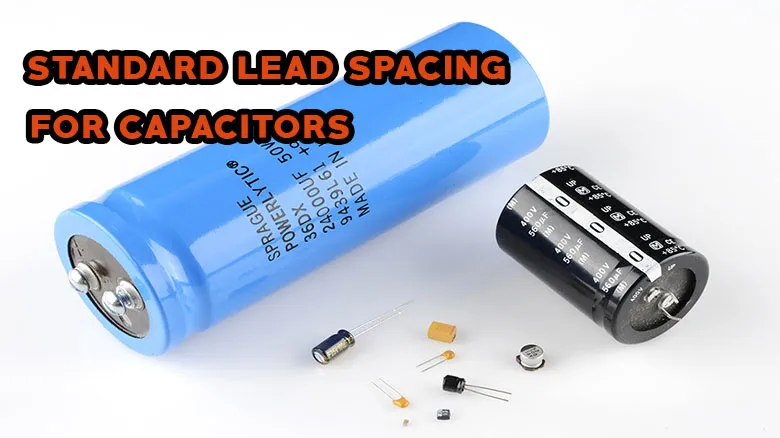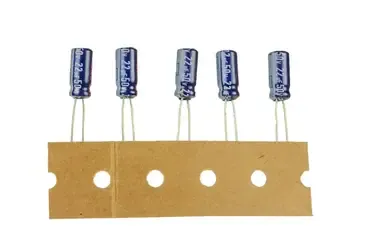What is the Standard Lead Spacing for Capacitors?

What is the Standard Lead Spacing for Capacitors
When designing electronic circuits, it is imperative to understand the standard lead spacing for capacitors. Printed circuit boards (PCBs) are constructed based on the lead spacing of an electronic assembly. Capacitors are mounted and connected based on their lead spacing.
Using standard lead spacing facilitates the placement, soldering, and electrical connections of capacitors in circuits, ensuring compatibility and ease of use. The purpose of this article, which is What is the Standard Lead Spacing for Capacitors is to provide engineers, hobbyists, and anyone who works with electronics with an understanding of the common standards and recommended lead spacings for capacitors.
What Is the Standard Lead Spacing for Capacitors?
It is the International Institute of Printed Circuits(IPC) that sets international standards for capacitors. Assembling and producing electrical components should be standardized by this association.
The leads of your capacitor will have to be bent if their spacing does not match the hole spacing on your PCB. This will prevent excessive mechanical stress on the capacitor. However, do not bend it too close to the body of your capacitor.

Lead Spacing for Capacitors
What Are the Leads On a Capacitor?
There are metal terminals on the body of a capacitor that extend from its leads. A capacitor typically consists of a positive (+) lead and a negative (-) lead.
As capacitors are operated and installed, these leads serve several important functions:
Mounting: Capacitors are mounted to circuit boards or sockets with the help of their leads. It ensures reliable electrical contact when the leads of the capacitor are inserted into appropriate holes or soldered onto designated pads;
Identification:
In addition to identifying the voltage rating and capacitance of a capacitor, leads are also used to determine the type of capacitor. A capacitor lead can also confirm the capacitor specification and value in addition to being marked with a color code or marked with a marking.
Polarity:
Most capacitors are polarized, in contrast to resistors, which are non-polarized. Capacitors are oriented in circuits by their positive and negative leads. Circuits or components can be damaged or malfunctioned if polarized capacitors are connected incorrectly.
Electrical Connection: An electric current flows through a capacitor via its leads. Capacitors have positive and negative leads through which current enters and exits. Through this flow of charge, electrical energy can be stored and released as needed.
Does The Length of Capacitor Matter?
It is important to understand capacitor construction in order to grasp the significance of capacitor length. Dielectric material separates two conductive plates in capacitors. Surface area, distance between plates, and dielectric constant of the material all affect capacitance, which is the amount of charge the capacitor can store. A capacitor's length depends primarily on its area, while its width is determined by its separation between the plates.
A capacitor's capacitance is not directly affected by its length most of the time. Larger plates result in a higher capacitance, as their surface area determines their capacitance. A component's shape or aspect ratio is not affected by capacitor length.
In addition to length, changes in width and thickness can also affect capacitance.
Capacitance can be indirectly affected by capacitor length, though in some cases it has no direct impact. High-frequency applications may be affected by parasitic inductance caused by the capacitor's physical length. A capacitor's size and form factor can also be affected by its length in space-constrained designs.
What Is the Standard Lead Spacing for Capacitors?
It depends on the size and type that determines the standard lead spacing in the capacitor. Often, radial film capacitors with small lead spacings use a 5 mm standard. There is, however, no standard lead spacing for capacitors of other types.
Lead spacings for ceramic disk capacitors, for example, can range from 7.5 mm to 10 mm, while lead spacings for wound capacitors can range from 10 mm to 37.5 mm. It is usually decided on the lead spacing based on the application requirements and standards or regulations that must be met.
How Do You Extend a Capacitor Lead?
In accordance with the application and requirements, there are various methods for extending the lead of a capacitor.
The most popular way to extend a lead is to solder further wire to it, making sure to ensure a solid electrical connection. To prevent damage to the capacitor or other components, it is critical to use the proper gauge of wire and to use appropriate methods for ensuring that the wire can handle the required current and voltage levels.
Connecting the capacitor to other components in the circuit can also be done with jumper wires or PCB traces.
Why Is Lead Spacing Important For Capacitors?
The electrical connections between capacitors and other components are ensured if the leads are spaced correctly.
Different capacitor lead spacings are available depending on the application, such as voltage rating, capacitance, and physical size. Standard and regulatory requirements may also determine the lead spacing.
When leads are spaced properly, short circuits can be reduced, capacitors can be protected, and the circuit will function reliably. As well as affecting capacitance, inductance, and impedance, lead spacing may affect capacitor electrical characteristics. In order to achieve an optimal lead spacing, it is important to consider the specific requirements and application when choosing the lead spacing.
Faqs
Question 1: Is there a reason why some capacitors have three leads?
Answer: A capacitor with three leads is especially common when its capacitance can be adjusted. By adjusting the contact between the wiper and the main capacitor plates, a variable capacitance is achieved by adding or subtracting leads from the main capacitor. These capacitors are commonly called trimming capacitors or variable capacitors.
Question 2: How many terminals are there on a capacitor?
Answer: There are usually two terminal leads on a capacitor. Capacitors are connected to electronic circuits by these leads, which allow current to flow in and out of them.
Question 3: What is the 2 3 rule of capacitor placement?
Answer: Integrated circuits (ICs) should receive decoupling capacitors close to their power pins based on the 2-3 rule for capacitor placement. Within 2 mm of the power pin and 3 mm of each other, two capacitors - one smaller and one larger - should be placed. IC performance is improved by reducing noise and improving performance by reducing inductance in the power supply path.
Question 4: A capacitor has how many leads?
Answer: A capacitor usually has two leads, a positive (+) and a negative (-). In an electronic circuit, these leads connect the capacitor to the circuit board. However, capacitors with extra leads are available for specialized applications, for example, as an exception.
Final Thoughts
Capacitors aren't electrically characterized by their lead spacing or pitch. Only mechanical fits are possible with these pitch dimensions. The holes on your board are spaced according to their corresponding distance. If you are still confused about what is the standard lead spacing for capacitors, then you can tell me via the comment section. Thank You!
Related Articles
Tantalum vs Ceramic Capacitor: What's the Differences?
What Is CBB61 Capacitor - Function and Applications
What is the Standard Lead Spacing for Capacitors?
What Is CBB61 Capacitor - Function and Applications
What Causes Capacitors to Fail
Tantalum vs Ceramic Capacitor: What's the Differences?
Run Capacitor vs Start Capacitor
Radial vs Axial Capacitor: Whats the Differences?
Polyester vs Polypropylene Capacitors: Explained
Polarized vs Non-Polarized Capacitor
How to Test a Hard Start Capacitor [Complete Guide]
How to Install a Capacitor to Two Amps










